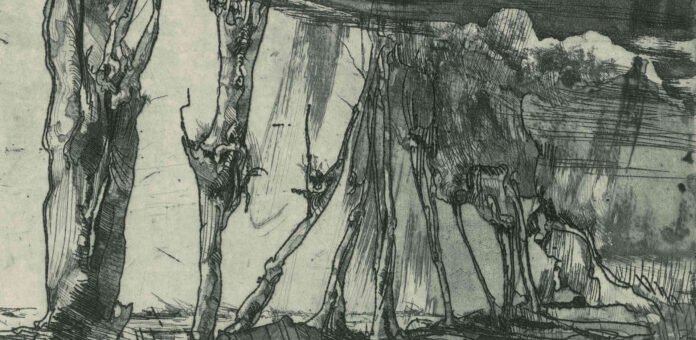The theme of trees is not only temporarily present at the Kulturforum in the form of the artistic project Baumschule Kulturforum. There are many works in the Gemäldegalerie and the Kupferstichkabinett that illustrate that trees have long played a role in visual art. Apart from a few exceptions, however, in older art, trees tended to only function as staffage, serving merely to frame the true subject matter of the work.
Things are very different in the production of the graphic artist Horst Janssen (Wandsbek bei Hamburg 1923–1995 Hamburg). From the early 1970s onwards, trees in moor and meadow landscapes began to appear in the foreground of his works. His interrogation of the tree as the protagonist of his richly thematic works on paper reached its highpoint in the mid-1980s with his 25-part work Laokoon: Die Bäume der Annette (Laocoön: The Trees of Annette).
The Pollard Widow as Motif
Almost without exception, it is pollarded willows, typically found near bodies of water, which unfurl their own idiosyncratic lives in Janssen’s landscapes. This type of tree that so fascinated the artist is a silver or basket willow that has been altered over a long period by humans in order to use it as a resource. Trunk is cut off after at a certain height when the tree is young, causing new, thin branches sprout from this point. Over time, a bulge forms at the top of the trunk calling to mind a human head (hence its German name Kopfweide, literally “head willow”). When they are then left to grow naturally, the spindly branches grow into thick, heavy branches. These can cause the trunk to split apart without completely killing the tree.
It is this “primordial” character of pollard willows that Horst Janssen dramatises and exaggerates in his graphic works. The wild branches of his willows, which mutate into moody individuals, reflect the mannerisms, temperament, and passions of the artist – including feelings of love.
In Dialogue with the Old Masters
Despite all his overabundant creative energy and stylistic idiosyncrasy, Horst Janssen finds numerous sources of inspiration in European and Asian art history, taking them as points of departure for his highly individual formal creations. These references mean that we can perceive echoes of the graphic arts of the 16th and 17th century in his works. Multiple pictures featured in the exhibition provide evidence of the pre-history of Horst Janssen’s “infatuation with trees”. They can be found in works by Albrecht Altdorfer and Wolf Huber – two key figures from the Danube School – as well as by Rembrandt and Titian. The theme of (pollard) willows can also be found in the work of Rembrandt and Huber.
“Laocoön: The Trees of Annette”
In the central figure of Laocoon wrestling with a deadly snake and rebelling against his fate, the artist sees a parallel to the furious struggle for survival of the pollarded willow. In his etchings, Horst Janssen uses various kinds of paper, hues and etching procedures to explore this unique arboreal form of life with technical finesse and a lust for experimentation.
Curator
This exhibition is curated by Andreas Schalhorn, curator for modern art at the Kupferstichkabinett
A special exhibition by the Kupferstichkabinett in the Gemäldegalerie of the Staatliche Museen zu Berlin
Source : Museen zu Berlin






